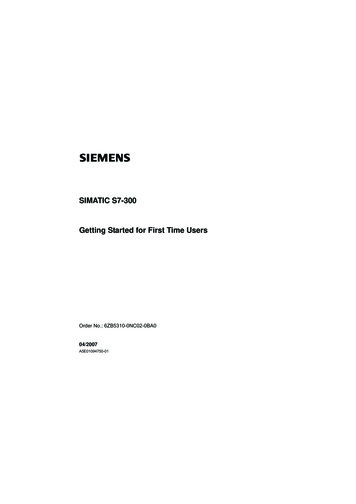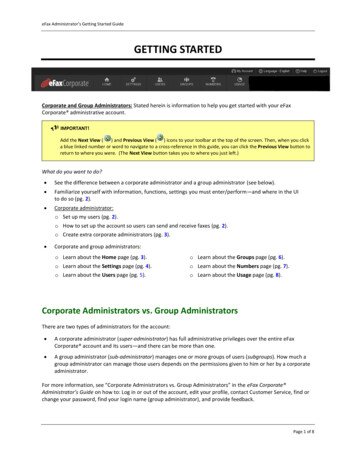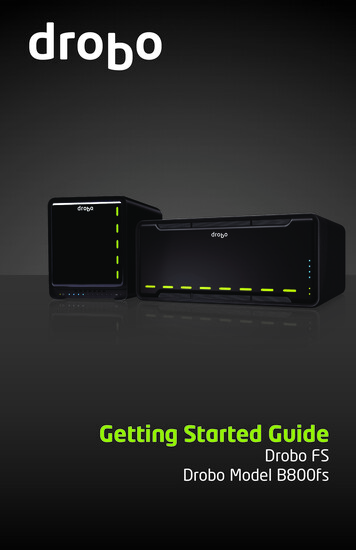
Transcription
Dell PowerConnect 8024 and 8024F SwitchesGetting Started Guide使用入门指南入門指南Guide de mise en routeHandbuch zum EinstiegPanduan Pengaktifanはじめに시작 안내서Guía de introducciónBaşlangıç Kılavuzu מדריך תחילת עבודה Model PC8024 and PC8024Fw w w. d e l l . c o m s u p p o r t . d e l l . c o m
Dell PowerConnect 8024 and 8024F SwitchesGetting Started GuideModel PC8024 and PC8024Fw w w. d e l l . c o m s u p p o r t . d e l l . c o m
Notes, Notices, and CautionsNOTE: A NOTE indicates important information that helps you make better use of your computer.NOTICE: A NOTICE indicates either potential damage to hardware or loss of data and tells you how to avoid the problem.CAUTION: A CAUTION indicates a potential for property damage, personal injury, or death.Information in this document is subject to change without notice. 2009 Dell Inc. All rights reserved.Reproduction in any manner whatsoever without the written permission of Dell Inc. is strictly forbidden.Trademarks used in this text: Dell, the DELL logo, and PowerConnect are trademarks of Dell Inc.; Microsoft and Windows are registeredtrademarks of Microsoft Corporation.Other trademarks and trade names may be used in this document to refer to either the entities claiming the marks and names or their products.Dell Inc. disclaims any proprietary interest in trademarks and trade names other than its own.Model PC8024 and PC8024FNovember 2009P/N X472KRev. A02
ContentsInstallationSite Preparation . . . . . . . . . . . . . . . . . . . . . . . . . . . . .Unpacking the Switch. . . . . . . . . . . . . . . . . . . . . . . . . . .5. . . . . . . . . . . . . . . . . . . . . . . . . .56. . . . . . . . . . . . . . . . . . . . . . . . . . .6Package Contents .Unpacking Steps .Mounting the Switch.5. . . . . . . . . . . . . . . . . . . . . . . . . . . . . . . . . . . . . . . . . . .67. . . . . . . . . . . . . . . . . . . . .7Installing in a Rack . . . . . . . .Installing as a Free-standing SwitchConnecting a Switch to a TerminalConnecting a Switch to a Power Supply. . . . . . . . . . . . . . . . . . . . . . . . . . . . . . . . . . .8Starting and Configuring the SwitchConnecting the Terminal to the Switch. . . . . . . . . . . . . . . . . . .9Booting the Switch. . . . . . . . . . . . . . . . . . . . . . . . . . . .10Initial Configuration. . . . . . . . . . . . . . . . . . . . . . . . . . . .10. . . . . . . . . . .111112. . . . . . . . . . . . . . . . . . . . . . . . . .15Management Interface and Out-of-Band InterfaceInitial Configuration Procedure. . . . . . . . . .Example Session . . . . . . . . . . . . . . . .Advanced Configuration. . . . . . . . . . . . . . . . . . . . . . . . . . . . . .1516. . . . . . . . . . . . . . . .19. . . . . . . . . . . . . . . . . . . . .1919Retrieving an IP Address From a DHCP Server . . .Security Management and Password Configuration . . . . . . . . . .Managing the SwitchUsing a Web Browser to Manage the SwitchStarting the Application . . .Understanding the Interface . . . . . . . . . . . . . . . . . . . . .3
4
InstallationThis document provides basic information to install, configure, and operateDell PowerConnect 8024 and 8024F systems. For more information, see the User’s Guide,which is available on your User Documentation CD, or check the Dell Support web site atsupport.dell.com for the latest updates on documentation and firmware.Site PreparationPowerConnect 8024 and 8024F switches can be mounted in a standard 48.26-cm (19-inch) rackor left freestanding (placed on a flat surface) and function as stand-alone switches.Before installing the switch or switches, make sure that the chosen installation location meetsthe following site requirements: Power — The switch is installed near an easily accessible 100–250 VAC, 50–60 Hz outlet. Clearance — There is adequate front and rear clearance for operator access. Allow clearancefor cabling, power connections, and ventilation. Cabling — The cabling is routed to avoid sources of electrical noise such as radiotransmitters, broadcast amplifiers, power lines, and fluorescent lighting fixtures. Ambient — The ambient switch operating temperature range is 0 to 45ºC (32 to 113ºF) at arelative humidity of up to 95 percent, non-condensing.Unpacking the SwitchPackage ContentsWhen unpacking each switch, make sure that the following items are included: One PowerConnect switch Two AC power cables One RJ-45 to DB9 female cable One rack-mount kit for rack installation (two mounting brackets, bolts, and cage nuts) One set of self-adhesive rubber pads for the free-standing switch (four pads are included) User Documentation CD Getting Started Guide Product Information GuideGetting Started Guide5
www.dell.com support.dell.comUnpacking StepsNOTE: Before unpacking the switch, inspect the container and immediately report any evidenceof damage.1Place the container on a clean, flat surface and cut all straps securing the container.2Open the container or remove the container top.3Carefully remove the switch from the container and place it on a secure and clean surface.4Remove all packing material.5Inspect the product and accessories for damage.Mounting the SwitchCAUTION: Read the safety information in the Product Information Guide as well as the safetyinformation for other switches that connect to or support the switch.The two AC power connectors are on the back panel of the switch.Installing in a RackCAUTION: Do not use rack mounting kits to suspend the switch from under a table or desk, or attach itto a wall.CAUTION: Disconnect all cables from the switch before continuing. Remove all self-adhesive padsfrom the underside of the switch, if they have been attached.CAUTION: When mounting multiple switches into a rack, mount the switches from the bottom up.1Place the supplied rack-mounting bracket on one side of the switch, ensuring that themounting holes on the switch line up to the mounting holes in the rack-mounting bracket.Figure 1 illustrates where to mount the brackets.Figure 1. Attaching the Brackets6Getting Started Guide
2Insert the supplied bolts into the rack-mounting holes and tighten with a screwdriver.3Repeat the process for the rack-mounting bracket on the other side of the switch.4Insert the switch into the 48.26 cm (19 inch) rack, ensuring that the rack-mounting holes onthe switch line up to the mounting holes in the rack.5Secure the switch to the rack with either the rack bolts or cage nuts and cage nut bolts withwashers (depending on the kind of rack you have). Fasten the bolts on bottom beforefastening the bolts on top.NOTICE: Make sure that the ventilation holes are not obstructed.CAUTION: Make sure that the supplied rack bolts fit the pre-threaded holes in the rack.Installing as a Free-standing SwitchNOTICE: We strongly recommend mounting the switch in a rack.Install the switch on a flat surface if you are not installing it in a rack. The surface must be ableto support the weight of the switch and the switch cables. The switch is supplied with fourself-adhesive rubber pads.1Attach the self-adhesive rubber pads on each location marked on the bottom of the switch.2Set the switch on a flat surface, and make sure that it has proper ventilation by leaving 5 cm(2 inches) on each side and 13 cm (5 inches) at the back.Connecting a Switch to a Terminal1Connect the DB9 connector of the RJ-45-to-DB9 serial cable to a VT100 terminal or to acomputer running VT100 terminal emulation software.2Connect the RJ-45 connector at the other end to the top RJ-45 port on the rear panel of theswitch. For more information about the location of the console port, see Figure 3.Getting Started Guide7
www.dell.com support.dell.comConnecting a Switch to a Power SupplyCAUTION: Read the safety information in the Product Information Guide as well as the safetyinformation for other switches that connect to or support the switch.The PowerConnect 8024 and 8024F switches have two power supplies for redundant or loadsharing operation. Each power supply can support 300W. Figure 2 illustrates the location of thetwo power receptacles on the rear panel.1Connect one of the supplied AC power cables to one of the AC power connectors located onthe rear panel.2To provide a redundant source of power, connect the second supplied AC power cable to theother AC power connector located on the rear panel.NOTE: Do not connect the power cable to a grounded AC outlet at this time. Connect the switch to apower source as described in the step detailed in "Starting and Configuring the Switch".Figure 2. Connecting Power Cables8Getting Started Guide
Starting and Configuring the SwitchAfter completing all external connections, connect a terminal to a switch to configure the switch.Additional advanced functions are described in the User's Guide located on yourUser Documentation CD.NOTE: Read the release notes for this product before proceeding. You can download the release notesfrom the Dell Support website at support.dell.com.NOTE: We recommend that you obtain the most recent version of the user documentation from the DellSupport website at support.dell.com.Connecting the Terminal to the SwitchTo monitor and configure the switch via serial console, use the console port on the rear of theswitch to connect it to a VT100 terminal or to a computer running VT100 terminal emulationsoftware. The console port is implemented as a data terminal equipment (DTE) connector.The following is required to use the console port: VT100-compatible terminal or a desktop or a portable system with a serial port, runningVT100 terminal emulation software. A serial cable (provided) with a RJ-45 connector for the console port and DB9 connector forthe terminal.Perform the following tasks to connect a terminal to the switch console port:1Connect the DB9 connector on the serial cable to the terminal running VT100 terminal emulationsoftware.2Configure the terminal emulation software as follows:aSelect the appropriate serial port (serial port 1 or serial port 2) to connect to the console.bSet the data rate to 9600 baud.cSet the data format to 8 data bits, 1 stop bit, and no parity.dSet the flow control to none.eSet the terminal emulation mode to VT100.fSelect Terminal keys for Function, Arrow, and Ctrl keys. Make sure that the setting is forTerminal keys (not Microsoft Windows keys).NOTE: When using HyperTerminal with Microsoft Windows 2000, make sure that you have Windows2000 Service Pack 2 or later installed. With Windows 2000 Service Pack 2, the arrow keys functionproperly in HyperTerminal's VT100 emulation. Go to www.microsoft.com for more information onWindows 2000 service packs.3Connect the RJ-45 connector on the cable directly to the switch console port. ThePowerConnect 8024 and 8024F console port is located on the rear panel, above the RJ-45out-of-band port, as shown in Figure 3.Getting Started Guide9
www.dell.com support.dell.comFigure 3.Connecting to the Console PortConsole PortThe RJ-45 port below the Console port is for out-of-band management.Booting the Switch1Make sure that the switch console port is connected to a VT100 terminal or VT100 terminalemulator via the RJ-45 to DB9 female cable.2Locate two AC power receptacles.3Deactivate the AC power receptacle.4Connect both of the switch power supplies to the AC receptacles.5Activate the AC power receptacles.When the power is turned on with the local terminal already connected, the switch goes through apower-on self-test (POST). POST runs every time the switch is initialized and checks hardwarecomponents to determine if the switch is fully operational before completely booting. If POSTdetects a critical problem, the program flow stops. If POST passes successfully, valid firmware isloaded into RAM. POST messages are displayed on the terminal and indicate test success or failure.The boot process runs for approximately 60 seconds.Initial ConfigurationNOTE: The initial simple configuration procedure is based on the following assumptions: The PowerConnect switch was never configured before and is in the same state as when youreceived it. The PowerConnect switch booted successfully. The console connection was established and the Dell Easy Setup Wizard prompt appears onthe screen of a VT100 terminal or terminal equivalent.The initial switch configuration is performed through the console port. After the initialconfiguration, you can manage the switch either from the already-connected console port orremotely through an interface defined during the initial configuration.NOTE: The switch is not configured with a default user name and password.NOTE: All of the settings below are necessary to allow the remote management of the switch throughTelnet (Telnet client) or HTTP (Web browser).10Getting Started Guide
Before setting up the initial configuration of the switch, obtain the following information fromyour network administrator: The IP address to be assigned to the management VLAN. The IP subnet mask for the network. The IP address of the management VLAN default gateway.Management Interface and Out-of-Band InterfaceThe front panel of the PowerConnect 8024 and 8024F switches contains multiple 10-GigabitEthernet ports for data traffic. Additionally, you can use any port on the front panel as thein-band management interface. The rear panel contains a Gigabit Ethernet port for out-of-band(OOB) management. The OOB port is located below the console port.The Dell Easy Setup Wizard configures network information for the in-band managementinterface. To use the OOB interface for management, use the Command Line Interface (CLI)to configure network information. You can assign a static IP address and subnet mask or enableDHCP and allow a DHCP server to assign the information automatically.NOTE: DHCP can be enabled on either the management interface or the OOB interface, but not both.DHCP is enabled by default on the management interface. To use DHCP on the OOB interface, you mustfirst disable it on the management interface and then enable it on the OOB interface.See the PowerConnect 8024 and 8024F CLI Reference Guide for information about thecommands to use to configure the OOB interface.Initial Configuration ProcedureYou can perform the initial configuration using the Dell Easy Setup Wizard, or by using theCommand Line Interface (CLI). The Setup Wizard automatically starts when the switchconfiguration file is empty. You can exit the wizard at any point by entering [ctrl z], but allconfiguration settings specified will be discarded (the switch will use the default values).NOTE: If you do not run the Easy Setup Wizard or do not respond to the initial Easy Setup Wizard promptwithin 60 seconds, the switch enters CLI mode. If the switch is connected to your network through themanagement interface when you power it on for the first time, it attempts to acquire an IP address from aDHCP server. If no DHCP server responds to the request within 50 seconds, the switch uses 192.168.2.1 asthe default IP address on the management VLAN. To view the management interface IP address, enterthe enable command to enter Privileged EXEC mode, and then enter show ip interfacemanagement. There is no default IP address for the OOB interface.Getting Started Guide11
www.dell.com support.dell.comFor more information on CLI initial configuration see the User Guide. This Getting Started Guideshows how to use the Setup Wizard for initial switch configuration. The wizard sets up the followingconfiguration on the switch: Establishes the initial privileged user account with a valid password. The wizard configuresone privileged user account during the setup. Enables CLI login and HTTP access to use the local authentication setting only. Sets up the IP address for the management VLAN. Sets up the SNMP community string to be used by the SNMP manager at a given IP address.You may choose to skip this step if SNMP management is not used for this switch. Allows you to specify the management server IP or permit management access from all IPaddresses. Configures the default gateway IP address.Example SessionThis section describes an Easy Setup Wizard session. The following values are used by the examplesession: The SNMP community string to be used is public The network management system IP address is 192.168.2.1. The user name is admin, and password is admin123. The IP address for the management VLAN is 192.168.2.1:255.255.255.0. The default gateway is 0.0.0.0.The setup wizard configures the initial values as defined above. After you complete the wizard, theswitch is configured as follows: SNMPv1/2c is enabled and the community string is set up as defined above. SNMPv3 isdisabled by default. The admin user account is set up as defined. A network management system is configured. From this management station, you can accessthe SNMP, HTTP, and CLI interfaces. You may also choose to allow all IP addresses to accessthese management interfaces by choosing the (0.0.0.0) IP address. An IP address is configured for the default management VLAN (1). A default gateway address is configured.NOTE: In the example below, the possible user options are enclosed in [ ]. Also, where possible, thedefault value is provided in { }. If you press Enter with no options defined, the default value is accepted.Help text is in parentheses.12Getting Started Guide
The following example contains the sequence of prompts and responses associated with running anexample Dell Easy Setup Wizard session, using the input values listed above.After the switch completes the POST and is booted, the following dialog appears:Unit 1 - Waiting to select management unit) Applying configuration, please wait .Welcome to Dell Easy Setup WizardThe Setup Wizard guides you through the initial switchconfiguration, and gets you up and running as quickly as possible.You can skip the setup wizard, and enter CLI mode to manuallyconfigure the switch. You must respond to the next question to runthe setup wizard within 60 seconds, otherwise the system willcontinue with normal operation using the default systemconfiguration.Note: You can exit the setup wizard at any point byentering [ctrl z].Would you like to run the setup wizard (you must answer thisquestion within 60 seconds)? [Y/N] yStep 1:The system is not setup for SNMP management by default. To managethe switch using SNMP (required for Dell Network Manager) you can.Set up the initial SNMP version 2 account now.Return later and setup other SNMP accounts. (For moreinformation on setting up an SNMP version 1 or 3 account, seethe user documentation).Would you like to setup the SNMP management interface now? [Y/N] yTo setup the SNMP management account you must specify themanagement system IP address and the "community string" orpassword that the particular management system uses to access theswitch. The wizard automatically assigns the highest access level[Privilege Level 15] to this account. You can use Dell NetworkManager or other management interfaces to change this setting andto add additional management systems later. For more informationon adding management systems, see the User’s Guide.Getting Started Guide13
www.dell.com support.dell.comTo add a management station:Please enter the SNMP community string to be used [public]:publicNOTE: If it is configured, the default access level is set to the highest available access for the SNMPmanagement interface. Initially only SNMPv1/2c will be activated. SNMPv3 is disabled until you return toconfigure security access for SNMPv3 (e.g. engine ID, view, etc.).Please enter the IP address of the Management System (A.B.C.D) orwildcard (0.0.0.0) to manage from any Management Station{0.0.0.0}: 192.168.2.100Step 2:Now we need to setup your initial privilege (Level 15) useraccount. This account is used to login to the CLI and Webinterface. You may setup other accounts and change privilegelevels later. For more information on setting up user accounts andchanging privilege levels, see the user documentation.To setup a user account:Please enter the user name. [admin]:adminPlease enter the user password:********Please reenter the user password:********Step 3:Next, an IP address is setup. The IP address is defined on thedefault VLAN (VLAN #1), of which all ports are members. This is theIP address you use to access the CLI, Web interface, or SNMPinterface for the switch. Optionally you may request that thesystem automatically retrieve an IP address from the network viaDHCP (this requires that you have a DHCP server running on thenetwork).To setup an IP address:Please enter the IP address of the device (A.B.C.D) or enter "DHCP"(without the quotes) to automatically request an IP address fromthe network DHCP server. [192.168.2.1]:192.168.2.1Please enter the IP subnet mask (A.B.C.D or /nn).[255.255.255.0]:255.255.255.014Getting Started Guide
Step 4:Finally, setup the default gateway. Please enter the IP address ofthe gateway from which this network is reachable. [0.0.0.0]:This is the configuration information that has been collected:SNMP Interface "public"@192.168.2.100User Account setup adminPassword ********Management IP address 192.168.2.1 255.255.255.0Default Gateway 0.0.0.0Operation Mode NormalStep 5:If the information is correct, please select (Y) to save theconfiguration, and copy to the start-up configuration file. If theinformation is incorrect, select (N) to discard configuration andrestart the wizard: [Y/N] yThank you for using Dell Easy Set up Wizard. You will now enter CLImode.Advanced ConfigurationThis section provides summary information about such common tasks as: Retrieving an IP Address From a DHCP Server Security Management and Password ConfigurationNOTE: For detailed information on all the CLI commands available for the 8024 and 8024F M6348switches, see the CLI Reference Guide.Retrieving an IP Address From a DHCP ServerWhen using the DHCP protocol to retrieve an IP address, the switch acts as a DHCP client.To retrieve an IP address from a DHCP server, perform the following steps:1Select and connect any port to a DHCP server or to a subnet that has a DHCP server on it, inorder to retrieve the IP address.NOTE: You do not need to delete the switch configuration to retrieve an IP address for the D HCP server.2Enter the following commands to use the selected port for receiving the IP address.console#configconsole(config)#ip address dhcpThe interface receives the IP address automatically.Getting Started Guide15
www.dell.com support.dell.com3To verify the IP address, enter the show ip interface command at the system prompt as shownin the following example.console#show ip interfaceManagement Interface:IP Address. 10.240.4.125Subnet Mask. 255.255.255.0Default Gateway. 10.240.4.1Burned In MAC Address.00:10:18:82:04:35Network Configuration Protocol Current. DHCPManagement VLAN ID. 1Routing Interfaces:InterfaceIP AddressIP MaskNetdir MultiBcastCastFwd---------- --------------- --------------- -------- 0.0.0.0DisableDisableSecurity Management and Password ConfigurationSystem security is handled through the AAA (Authentication, Authorization, and Accounting)mechanism that manages user access rights, privileges, and management methods. AAA uses bothlocal and remote user databases. Data encryption is handled through the SSH mechanism.The system is delivered with no default password configured; all passwords are user-defined. If auser-defined password is lost, a password recovery procedure can be invoked from the Boot menu.The procedure is applicable for the local terminal only and allows a one-time access to the switchfrom the local terminal with no password entered.16Getting Started Guide
Configuring Security PasswordsThe security passwords can be configured for the following services: Console Telnet SSH HTTP HTTPSNOTE: When creating a user name, the default priority is "1", which allows access but not configurationrights. A priority of "15" must be set to enable access and configuration rights to the switch.Configuring an Initial Console PasswordTo configure an initial console password, enter the following commands:console(config)#aaa authentication login default lineconsole(config)#aaa authentication enable default lineconsole(config)#line consoleconsole(config-line)#login authentication defaultconsole(config-line)#enable authentication defaultconsole(config-line)#password secret123 When initially logging on to a switch through a console session, enter secret123 at thepassword prompt. When changing a switch’s mode to enable, enter secret123 at the password prompt.Configuring an Initial Telnet PasswordTo configure an initial Telnet password, enter the following commands:console(config)#aaa authentication login default lineconsole(config)#aaa authentication enable default lineconsole(config)#line telnetconsole(config-line)#login authentication defaultconsole(config-line)#enable authentication defaultconsole(config-line)#password pass1234 When initially logging onto a switch through a Telnet session, enter pass1234 at thepassword prompt. When changing a switch mode to enable, enter pass1234.Getting Started Guide17
www.dell.com support.dell.comConfiguring an Initial HTTP PasswordTo configure an initial HTTP password, enter the following commands:console(config)#ip http authentication localconsole(config)#username admin password user1234 level 15Configuring an Initial HTTPS PasswordTo configure an initial HTTPS password, enter the following commands:console(config)#ip https authentication localNOTE: You should generate a new crypto certificate each time you upgrade (install a new version of)the control software application on the switch.Enter the following commands once when configuring to use an HTTPS session over a console,a Telnet, or an SSH session.NOTE: In the Web browser enable SSL 2.0 or greater for the page content to appear.console(config)#crypto certificate 1 generateconsole(config)#ip https serverNOTE: Http and Https services require level 15 access and connect directly to the configuration levelaccess.18Getting Started Guide
Managing the SwitchYou can manage the switch by using the Web-based interface, command-line interface (CLI),or SNMP. To manage the switch by using a Web browser or SNMP, the switch must have an IPaddress, and it must be accessible from the management station. To manage the switch by usingthe CLI, you can use a direct console connection or a remote Telnet/SSH connection.To establish a direct console connection to the CLI, see "Connecting the Terminal to the Switch"on page 9. You can use the Easy Setup Wizard To perform the initial configuration that allowsremote management access (see "Initial Configuration Procedure" on page 11). For instructions onconfiguring remote management using the CLI, refer to the User’s Guide.Using a Web Browser to Manage the SwitchStarting the Application1Open a web browser.2Enter the switch’s IP address (as defined in the CLI) in the address bar and press Enter .For information about assigning an IP address to a switch, see "Initial Configuration" onpage 10.3When the Login window displays, enter a user name and password.NOTE: The switch is not configured with a default password, and you can configure the switch withoutentering a password when you connect to the CLI by using the console port. Passwords are both casesensitive and alpha-numeric. For information about recovering a lost password, see the User’s Guide.4Click OK.5The Dell OpenManage Switch Administrator home page displays.Understanding the InterfaceThe home page contains the following views: Tree view — Located on the left side of the home page, the tree view provides an expandableview of features and their components. Device view — Located on the right side of the home page, the device view is used to displaysuch things as a view of the device, an information or table area, and/or configurationinstructions.Getting Started Guide19
20Getting Started Guidewww.dell.com support.dell.com
Dell PowerConnect 8024 和 8024F 交换机使用入门指南型号 PC8024 和 PC8024Fw w w. d e l l . c o m s u p p o r t . d e l l . c o m
�知。 2009 Dell Inc. 版权所有,翻印必究。未经 Dell Inc. �本文中使用的商标:Dell、DELL 徽标和 PowerConnect 是 Dell Inc. 的商标; Microsoft 和 Windows 是 Microsoft Corporation ��品名称的公司或其制造的产品。 Dell Inc. ��号 PC8024 和 PC8024F2009 年 11 月P/N X472KRev. A02
目录安装现场准备. . . . . . . . . . . . . . . . . . . . . . . . . . . . . . . . .打开交换机包装. . . . . . . . . . . . . . . . . . . . . . . . . . . . .包装箱物品 .打开包装步骤安装交换机 . . . . . . . . . . . . . . . . . . . . . . . . . . . . . . . . . . . . . . . . . . . . . . . . . . . . . . .252526. . . . . . . . . . . . . . . . . . . . . . . .262627. . . . . . . . . . . . . . . . . . . . . . . . . . .27. . . . . . . . . . . . . . . . . . . . . . . . . . . . . . .在机架中安装 . . . ��端25将交换机连接至电源设备. . . . . . . . . . . . . . . . . . . . . . . . . . . . . . . . . . . . . . . . . . . . . . .28. . . . . . . . . . . . . . . . . . . . . . . . . . .29. . . . . . . . . . . . . . . . . . . . . . . . . . . . . . .30. . . . . . . . . . . . . . . . . . . . . . . . . . . . . . . . �交换机引导交换机 ��过程 . . . .示例会话 . . . . . . .高级配置. . . . . . . . . . . . . . . . . . . . . . . . . . . . . . . . . . . . . . . . . . . . . . . . . . . . . . . . . . . . . . . . . . . . . . . . . . . . . . . . . . . . . . . . . . . . . . . . . . . . . .从 DHCP 服务器检索 IP 地址 .安全保护管理和密码配置 . . . . . . . . . . . . . . . . . . . . . . . . . . . . . . . . . . . . . . . .353537管理交换
6 Getting Started Guide www.dell.com support.dell.com Unpacking Steps NOTE: Before unpacking the switch, inspect the container and immediately report any evidence of damage. 1 Place the container on a clean, flat surface and cut all straps securing the container. 2 Open the container or remove the container top. 3 Carefully remove the switch from the container and place it on a secure and .










